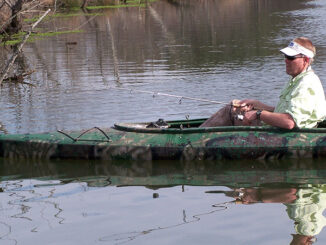
Springtime is prime time for casting hollow body frogs for bass
Spring has finally gained a foothold across the Carolinas, and that means it’s the perfect time to cast topwater, hollow-body frogs for largemouth bass.
Bass are on the prowl in the shallows and they are in every stage of the spawn. It’s a little later than normal for spawning on many Carolina lakes, ponds, and rivers, but this year’s weather kept pushing bass back off the banks and into staging areas.
But finally, the time is right, and frog lures are the ticket to some of the most fun and productive fishing of the year.
Anglers have never had so many lure choices when it comes to frogs. And even more importantly, frog bodies are softer than they’ve ever been, and hooks are surgically sharp. This means more solid hook sets for a lure and technique that has historically had a relatively low hookup ratio.
Brett Collins of Ridgeway, S.C., who runs the Carolina Anglers Team Trail (CATT), looks forward to this time of year because fishing with frogs is one of his favorite ways to catch bass.He has several tips that will help anyone fishing this way.
The right gear helps, starting with the proper rod.
“You’ve got to have a strong rod. I go with a rod with a heavy or extra heavy power rating. You need a lot of backbone. You can hook a fish on top of a big pod of lily pads or other surface weeds, and it can wrap you around every weed in the area. So a 5-pound bass becomes a 25-pound pile of weeds. A medium or medium heavy rod is outmatched here,” he said.
A baitcasting reel with a fast retrieve ratio is also a must.
“You don’t to work the frog at any certain speed, but you want to get that bass out of there as quickly as possible so it won’t wrap up in the weeds, which increases the chances of it getting free. The faster your reel is, the faster you can get it out of there,” he said.
Using the right line is another factor that Collins said anglers should pay close attention to.
“I don’t use anything less than 60-pound braided line. There’s just no reason to go smaller than that. It will cut through some of the weeds, and it will haul in plenty of weight, but it’s thin enough to get more than enough on your reel, and casts easily. If you think 25-pound test is good enough, you’re going to break off a lot of fish in the weeds,” he said.
Collins varies the speed that he works the frog based on the day’s conditions. He’ll reel faster or slower until he gets a feel for what is triggering strikes, and he said that can change throughout each day. He gives the rod a twitch, lets the frog settle, reels in the slack, then gives the rod another twitch. And he said anglers should resist the urge to reel the frog in quickly once it clears the weeds. Sometimes, a bass will follow the frog from below, then strike it once it gets into clear water.
Anglers also shouldn’t put the frog away when fishing areas without lily pads or surface grass. Downed timber, duckweed, and even a layer of pollen are all good places for attracting bass with frogs.
Finally, Collins said the reason many anglers miss fish with frog lures is because they try to set the hook upon seeing the fish bite. What they should do instead is reel in the slack, then set the hook only when they feel the pressure of the fish on the line. It all happens much more quickly than it sounds once you get the hang of it.





Be the first to comment